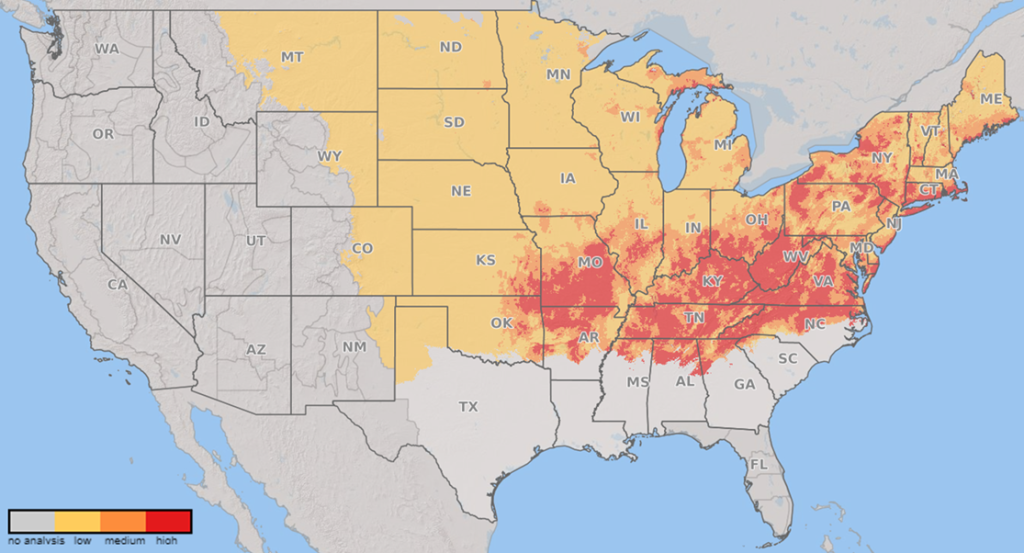Wheat Disease Update – 2 June 2022
Meriem Aoun, Small Grains Pathologist
Department of Entomology & Plant Pathology, Oklahoma State University.
Crown and root rot (Figure 1) was among the common diseases throughout the last two weeks of May. We observed this disease in multiple counties in Oklahoma including Cimmaron, Payne, Major, Texas, Beaver, Canadian, Kingfisher, and Alfalfa. Culturing from infected samples at the Plant Disease Diagnostic Lab at OSU showed that most samples were infected by Fusarium pseudograminearum. Fewer samples from Kingfisher, Alfalfa, Beaver, and Payne counties were infected by Bipolaris sorokiniana which causes common root rot. In these samples, Bipolaris Sorokiniana was often detected in combination with Fusarium pseudograminearum. Bipolaris Sorokiniana also caused spot blotch on the leaves in samples from Payne and Garfield counties.
 Figure 1. Symptoms of crown/root rot on the winter wheat variety ‘Atomic AX’ in a farmer field in Kingfisher, OK (Photo credit: Mike Johnson, Albaugh LLC).
Figure 1. Symptoms of crown/root rot on the winter wheat variety ‘Atomic AX’ in a farmer field in Kingfisher, OK (Photo credit: Mike Johnson, Albaugh LLC).
In Morris (Okmulgee County, East Central OK) and on May 31, I observed high incidence of Fusarium head blight (FHB or scab) as shown in Figure 2. Bleached heads with salmon-pink color spore masses were observed (Figure 3). Precipitations during May (around flowering time of the crop) favored the development of this disease. In addition, corn, which is another susceptible crop, was grown last year in this field contributing to the increase of the fungus inoculum in the soil. The FHB fungus produces a mycotoxin called deoxynivalenol (DON) which contaminates grain, increasing the likelihood for discounts or rejection of entire grain loads at the point of sale. This high FHB incidence in Morris agrees with the forecast from the wheat scab risk tool (www.wheatscab.psu.edu/), which showed that Eastern Oklahoma had medium-to-high scab risk (Figure 4).
 Figure 2. Symptoms of Fusarium head blight (scab) in a winter wheat field in Morris (Okmulgee County, Oklahoma).
Figure 2. Symptoms of Fusarium head blight (scab) in a winter wheat field in Morris (Okmulgee County, Oklahoma).
 Figure 3. Wheat head showing Fusarium head blight symptoms. Salmon-pink color on the spikelet corresponds to Fusarium spore masses (photo credit: Brian Olson, OSU Wheat Pathology Lab).
Figure 3. Wheat head showing Fusarium head blight symptoms. Salmon-pink color on the spikelet corresponds to Fusarium spore masses (photo credit: Brian Olson, OSU Wheat Pathology Lab).
 Figure 4. Scab risk map for the US based on six-day weather forecast (wheatscab.psu.edu, checked on June 2, 2022). Warmer red color corresponds to higher disease risk. Eastern Oklahoma had medium-to-high scab risk.
Figure 4. Scab risk map for the US based on six-day weather forecast (wheatscab.psu.edu, checked on June 2, 2022). Warmer red color corresponds to higher disease risk. Eastern Oklahoma had medium-to-high scab risk.
On June 1st, the OSU Disease Diagnostic Lab received a sample from Kay County showing dark chocolate chaff and tenacious glumes on the winter wheat variety ‘Green Hammer’ (Figure 5). I also observed these symptoms in other locations in Oklahoma including Balko (Beaver County), Lahoma (Garfield County), and Morris (Okmulgee County). These symptoms are triggered by environmental stresses such as drought and can be observed on the winter wheat varieties Green Hammer, ‘Bentley’, ‘Baker’s Ann’, and ‘Joe’.
 Figure 5. Dark chocolate chaff and tenacious glumes on winter wheat in Lahoma, Garfield County, Oklahoma.
Figure 5. Dark chocolate chaff and tenacious glumes on winter wheat in Lahoma, Garfield County, Oklahoma.